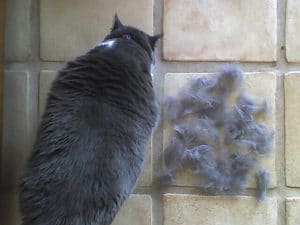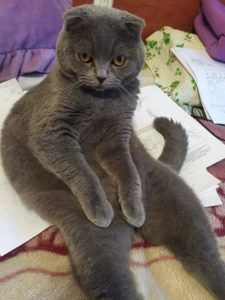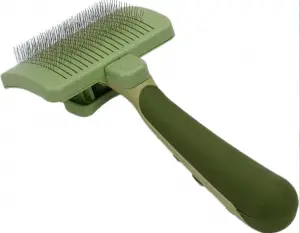Hair and Shedding in Scottish Folds
How to groom your Scottish Fold and how much do they shed
Cat owners everywhere can rejoice and agree on one thing – cats shed. Any home with a cat as a permanent inhabitant knows what cat hair looks like. Scottish Folds are no exception to that rule. In fact, rumor has it that Folds are heavy shedding cats.
Let’s talk break it down and talk about Scottish Fold coat types, grooming routines, and coping with cat hair.

Quick solutions
If you are in a hurry and want some quick solutions, here are my best two tips:
- Use a brush daily or once a couple of days. One of the best brush with self-cleaning (which will save you a lot of time) is the Safari Brush (link to Chewy.com). No wonders it has almost full 5-star ratings from over 600 reviews.
- Use an automatic vacuum cleaner robot. This will save you a lot of time and will easily clean the floors Pure Clean Robot (link to Chewy.com) is the one I recommend.
The brush will take care of most of the hair and in combination with the vacuum cleaner, it’s almost like owning a no-hair cat. Cats leave most of their footprint on the floor so that’s why the vacuum cleaner is so effective.
Scottish Fold coat types & hair length
Folds come in two varieties based on coat length. We have the long-haired kind and the short-haired, most common kind. Regardless of how long it is their fur is dense, double-layered, and plush.
Long-haired Scottish Folds
The fur’s length is medium to long. Usually, they have a “ruff” around their neck and a full, puffy tail. And to make them picture-perfect and more lovable even, they grow long ear tufts and toe tufts. The fur is generally denser around the legs, ears, and tail.
Short-haired Scottish Folds
This is the most encountered variety. The short hairs are dense and soft to the touch. A double-layered coat means that the cats grow short, close to the skin layer of hair, and a slightly longer layer that hides the short one. The dense hair makes Folds not suitable for allergic people. They tend to carry dust particles and debris that get stuck in the fur.

Colors & patterns
Folds come in a variety of colors and combinations of patterns and colors. To make a short classification, we have the main types:
- Single, plain colored – includes the basic white, black, cream, ginger, and blue/grey.
- Smoked colored – this means they have an undercoat or a first layer of coat with a softer nuance with darker overcoat or tips. Colors here vary from silver to cameo, black, golden, or chinchilla-like coating.
- Tabby – here you have your brown patterned, ginger, blue, or silver tabbies with spots, stripes, ticked or mackerel. There is a wide range that can turn into even more patterns depending on the parent’s coating.
- Other colors or patterns – include calico, blue-cream, two-colored (with patches or distinctive shapes), chocolate, or even lavender.
The color of the eyes usually matches the pattern and color of the fur.
Shedding patterns in Scottish Folds
Generally, Scottish Folds do not shed more than a regular cat. They do not require a lot of effort for grooming, but their dense coat does need constant brushing and care. Many owners feel like their Folds shed massively. In reality, because of the density, there is more hair to leave around.
Keeping up with a regular schedule of brushing is essential for the cat’s health and your home’s harmony. You will still see cat hair around, but you can control the amount by brushing to eliminate excess hair.
Depending on the length of the coat, you need to brush your short-haired Fold once a week, on average. If you own a long-haired kitty, then you need to brush at least twice a week. If that’s not enough, you can do it once a couple of days or even daily.

Another aspect is their living environment. If you live in an apartment and your cat is mostly indoors, then you do not have to brush more often. But, if you live in a house and your Scottish Fold is equally indoors and outdoors, then you need to step up your brushing times.
A cat that plays outside climbs trees, digs in the dirt or rolls in the grass will need a bit of extra attention. You have to remove the dirt caught in their hair by brushing regularly. More so if the coat is long.
Another observation is that indoor Scottish Folds tend to shed the same amount all year round. Their outdoorsy counterparts shed more during spring and autumn and less during the cold season. Also, the long-haired ones have a reputation to produce heavy fur mats. If you are the lucky owner of a Fold with long and light-colored hair, then you will have more work to do. White or light fur is more visible and might become a problem.
How to prevent massive shedding
There are a few reasons why your cat might shed more than usual. Fixing these can be the first step to controlling the amount of cat hair lying around the house.
Overweight or sick cat: If you fail to take proper care of your Fold, it might stop grooming itself. A healthy pet will also shed less or have no hair tangles. Overweight cats can have a hard time reaching out to certain spots and washing. Sick cats avoid self-grooming because they are in pain, lack energy, or feel discomfort. Make sure you create healthy conditions for your Fold!
Outdoor cats without proper grooming: If your Scottish Fold spends time outside, it needs more frequent grooming. Forgetting to do this regularly can lead to dirt buildup and matted hair. Wet hair is more susceptible to dirt retention. When outside, your cat might step into water or play around with it. Thus, remember to brush when it comes inside and remove hair tangles.
Once you’ve taken care of these aspects, it all comes down to regular brushing and care.
- Pick a good brush or comb. The ones with wide teeth are the most efficient. They can remove knots, pieces of dirt, leaves, or other outside residues.
- Use a detangler like a spray-on solution designed for cats or a talc-free powder. Make sure the ingredients are not toxic and safe to use on cat skin.
- Remove mats or tangles. Your Fold should not reach that stage, but long-haired ones are more at risk. If your notice mats of hair on your cat, remove them carefully with a brush or scissors. Always hold the hair with your fingers from the roots up. Then, gently pull the mat with a comb. If it’s too strong of a tangle, use scissors but make sure to protect the skin.
Another option is a mat comb or razor comb. It is specially designed to handle these situations. A set of blades are built into the comb and it cuts while you brush through the hair.

How to brush properly
You can ask for advice from your veterinarian or grooming salon professionals. Generally, they recommend brushing with a pins-brush or steel comb.
The type of comb with two sets of pins – a short one and a longer one – does a better job. It also reaches the underneath layer of hair in Scottish Folds. The result is more complete hair removal and effective skin massage for your pet.
The ones I recommend are:
- Safari Brush (link to Chewy.com)
- JW Pet Gripsoft Brush (link to Chewy.com)

Tip: Don’t be aggressive when brushing your cat because you might irritate the skin. Not to mention that your cat might try to get out brushing if the experience is dreadful. Use gentle strokes to get your Fold to relax. Then start to brush in the opposite direction of hair growth to remove dead hair best.
Conclusion
All in all, invest time and love in grooming your Scottish Fold and it will pay off. Give it good quality nutrition, regular visits to the vet, and a clean environment. Your lovely cat will do half the work anyway because they are very clean creatures. You bring the other half and your efforts will keep a hair-free home for both of you.